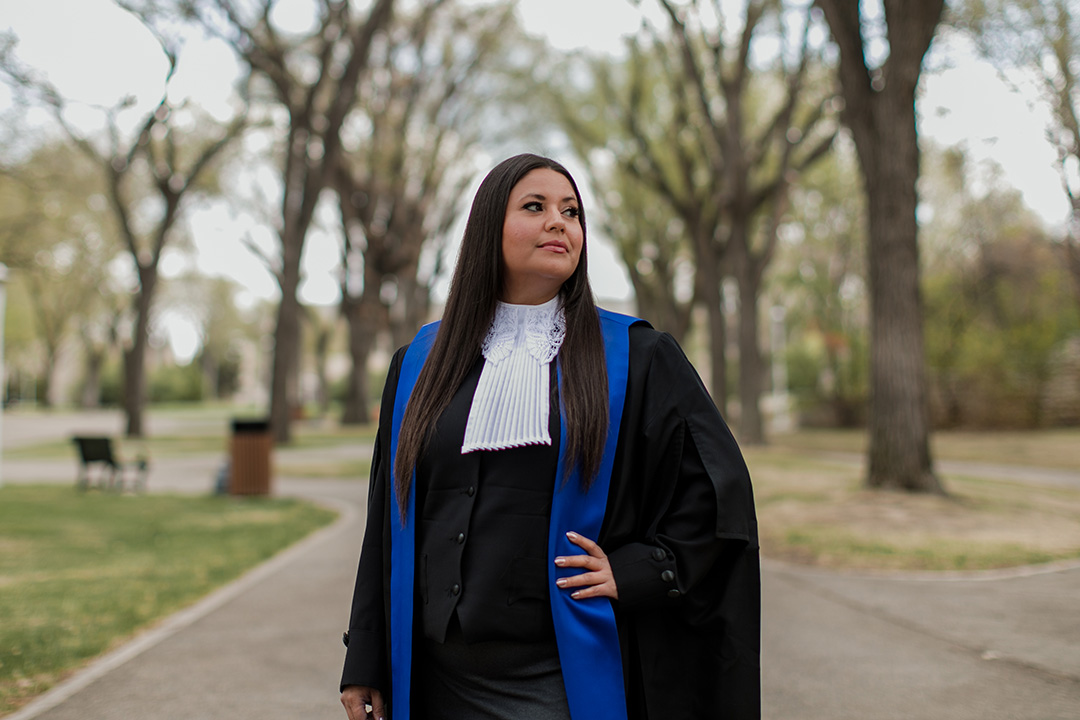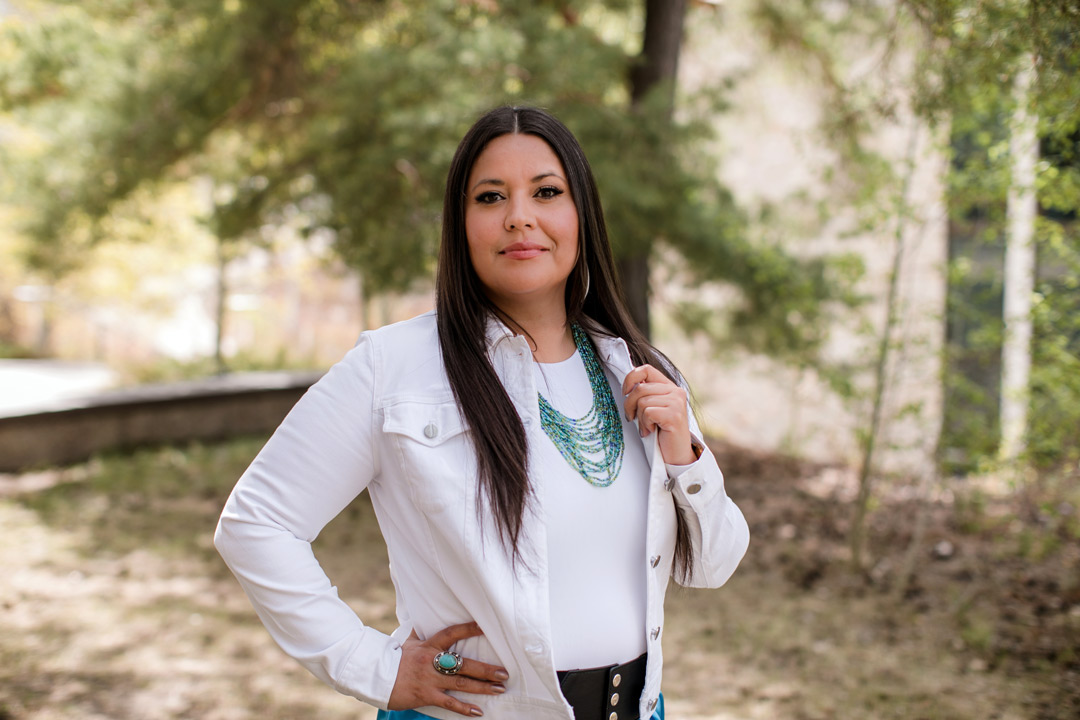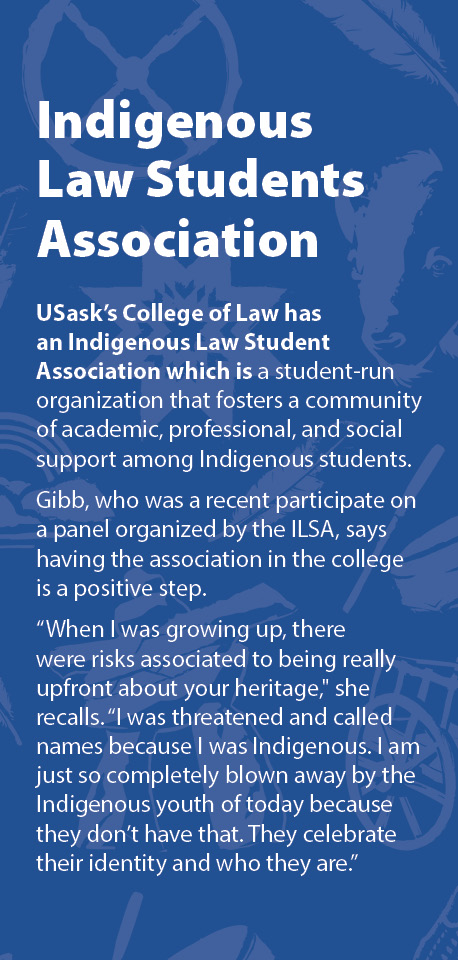
Changing the narrative
The racism Lua Gibb (LLB'05) endured as a young girl set a fire in her belly. She vowed to stand up for Indigenous people so no other little girls would endure the same prejudice she did.
By Leslie-Ann SchlosserOn the scenic South Saskatchewan River, just 90 kilometres north of Saskatoon, a peaceful and idyllic natural space acts as a journey through time.
The space, known as the Batoche National Historic Site, has been preserved to pay tribute to the historical conflict between the Canadian government and the Métis provisional government in 1885. It also commemorates the history, culture, and heritage of the Métis community.
The site welcomes thousands of visitors a year, including many school field trips that embark up the highway from Saskatoon to learn more about Métis history. One day in the early ’90s, while speaking to a group of Grade 4 students in the site’s Amphitheater, a park staff member continually referred to conflicts on the settlement as The Riel Rebellion.
From the back of the theatre, a small nine-year-old hand shot up amongst the crowd. The owner of the hand politely reminded the guide that the Métis people preferred the term Riel Resistance because resistance suggests the conflict resulted as an assertion of their rights against European authority.
The staff member instantly admitted the mistake and thanked the little nine-year-old voice for her insight and advanced wisdom. That young hand belonged to Lua Gibb. Even at that tender age, correcting and educating people about Indigenous culture was not new for her. In fact, it was part of her identity, engrained at a young age by her parents who were merciless in educating their children on Indigenous culture, prejudices, and misconceptions.
“That is a credit to my parents that we were not sheltered from the realities of the challenges faced by Indigenous people,” said Gibb. “I think the important lesson that my parents gave to my brothers and my sisters when we were growing up was the importance of standing up for justice.”
Gibb describes her childhood as nomadic. Her family moved constantly across Western Canada; from Saskatchewan, to British Columbia and even to the Yukon. Her mother is Indigenous and a member of the Onion Lake Cree Nation. Her father is non-Indigenous. Growing up in a mixed-race family came with its challenges. She saw and experienced many things in this transient lifestyle, but the one constant was the prejudices people held against her as an Indigenous person.
“Experiencing that racism over and over again really impacted me at a young age and it highlighted the importance that we need to build relationships and start breaking down the barriers between Indigenous and non-Indigenous communities,” said Gibb.
Her parents constantly acknowledged that their family would experience prejudices but always instilled the importance of advocacy and standing up for others. They even went so far as to name the family dog Oka as a way of acknowledging the 1990 Oka Crisis; a three-month standoff between Mohawk protesters, Quebec police, the RCMP and the Canadian military over traditional lands.
“Those were the kind of things, this incredible quiet resistance, that my mom and my dad endeavored to show our solidarity and to show the importance of always supporting and advocating for our people,” said Gibb.
Standing up for justice indeed runs deep in Gibb’s blood – so much so that while other four-year-olds were watching Sesame Street, Gibb was dreaming of a future in the courtroom. By the time she had learned to tie her shoes, she knew she wanted to be a lawyer so she could fight for social justice.
“The adversity I faced as a child in dealing with racism … helped shape me and my desire to go into justice at a very young age," said Gibb.
That passion for justice never did fade away. It followed her throughout her childhood and eventually to the steps of the University of Saskatchewan when she was just 18 years old.
The young advocate who had a knack for arguing fit right into the College of Law.
Gibb recalls immediately feeling connected with her classmates, many of whom were Indigenous.
“Being surrounded by other Indigenous students who had similar lived experiences to my own and building those relationships and friendships was great,” she said. “I've always had such a positive experience at the university.”
As a student, Gibb was never keen on criminal law. After graduating she was dead set on practicing Indigenous law, but a new passion was ignited while she was articling.
“I went to the Court of Queen's Bench and I observed a trial that was occurring and just the same way I knew as a child and a young person I was going to be a lawyer, I had a similar stance. This is where I am meant to be,” she said.
She was called to the bar in 2006 and became a Crown prosecutor in Saskatoon. This move didn’t come without its uncertainty for Gibb, because being a Crown prosecutor often meant being responsible for incarcerating Indigenous people. But she maintains that consequences are fundamental for building respect and is necessary for communities to grow and heal. She was also able to focus on serving the victims of crimes, many of whom were often Indigenous as well.

“The over-representation of Indigenous people in the court as accused persons and as victims was a significant factor that I wanted to work at addressing and understanding how that number could be improved upon,” she said.
In 2013, she was hired by the office of the Saskatchewan Advocate for Children and Youth as an Investigator and advocate for the North. Because of her time working as a Crown prosecutor in youth court, it was a cause near and dear to her heart. Gibb saw the way Indigenous youth looked at her when they entered the courtroom. Having an Indigenous figure represented in such a formal setting was monumental and she was dedicated to being a strong Indigenous role model.

“There was a significance for youth coming to court and seeing an Indigenous lawyer and understanding that I got where they were coming from,” said Gibb. “That was something that was so rewarding to me. To work with young people and to let them know I see you and I hear you.”
Although she loved her work, the call to law remained strong. In 2015, she accepted a position as senior counsel with the Public Prosecution Service of Canada. As a prosecutor, she continued her efforts towards reconciliation through her focus on the Truth and Reconciliation Calls to Action.
Through her many roles, Gibb had quickly grown a reputation as an influential advocate, confident litigator and extremely knowledgeable changemaker. After more than a decade of practicing law, several people began encouraging her to become a judge. However, her current work was extremely rewarding to her, to the point where she wasn’t ready to give it up.
Then came the death of Colten Boushie, the 22-year-old Indigenous man who was fatally shot on a rural Saskatchewan farm.
“After the death of Colten Boushie, I could not ignore the call for representation and the call for Indigenous people to be on the court. That is what shifted things for me,” said Gibb.
She took the leap, thinking it would take a few years of expressing her interest to eventually become a judge. To her surprise, she was appointed in January 2020 as a provincial court judge, becoming the current youngest judge and just one of five Indigenous judges in the province.
Six weeks after she was appointed, a global pandemic effectively shut down courtrooms across Saskatchewan. Because of COVID-19 restrictions, Gibb’s experience in trial court is limited, but she notes that the slower pace has helped her comfort level in becoming a decision maker. She says being the decision maker versus being an advocate has been the hardest transition, but she knows she can still continue to make an impact because of the lens she has as an Indigenous person and judge.
“Whether it's the judiciary or the court or the police force, diversity is such a fundamental aspect … because bringing that lens allows us to grow in our understanding and it creates space for learning and it creates opportunity to have the representative,” she said. “I'm just so grateful that I have the opportunity and that I am in this position now because I see the incredible work that we’re doing every day in provincial court trying to respond to the needs of our community, trying to create safer communities.”
Just one conversation with Gibb reveals that she is so much more than the robes she wears as a provincial court judge. She carries a profound wisdom well beyond her years in every facet of her life.
Beyond her role as a judge, she is a mother, an avid baker, a lover of nature, and a devoted sister and daughter. She maintains that most Indigenous people are just like her: Raising children and balancing life during a pandemic. Oftentimes what is highlighted or depicted in the media is predominately negative stories from Indigenous communities. To her, it is just as important to celebrate and raise the visibility of Indigenous success.
Take her family, for instance. She remains close to her parents to this day. Having just celebrated their 39th wedding anniversary this past year, they too, continue their crusade for justice as prominent teachers and leaders in their community. When things get tough, she uses them as a source of strength and inspiration to continue to achieve that four-year-old’s hopes and dreams.
“When I take off my robe, it’s not obvious that I’m a judge and I still experience racism and I still experience discrimination. I find that really humbling, because it reminds me of the importance of being compassionate and the importance of understanding and pausing, and considering that you know the challenges that people face when they come to court,” says Gibb.
“We have to keep working towards healing this path and healing the trauma so that we can improve our community."
Article re-posted on .
View original article.
